The Potato in Cuzco

The potato is the most important crop for Peruvian cuisine since it cannot be missing from almost any meal. It is also quite colorful, coming in a whole range of colors and varieties, some yellow, some white, some with dark lines, and others purple.
There are more than 4,000 varieties of potatoes and the vast majority of those are found in South America. Indeed , the potato is one of Peru’s contributions to the world. Because of its flexibility potatoes are now found in the recipes of the most varied cuisines around the world.
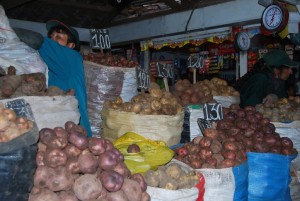
South Americans have grown potatoes for more than 8000 years and the potato was the most important food of the Inca Empire. They developed advanced techniques for storing the tuber. In addition, potatoes have a wide range of applications, both industrial and domestic. It can be stewed, boiled, baked, stir-fried, and fried. It shows up in mashed form, in creams, souffles, croquettes, and tortillas.
Among the different varieties of potatoes found in Cuzco the most consumed are the huayro, the white potato, the peruanita, the yellow, the canchan, suytus, and compis. Each of these has their own distinctive uses in our cuisine.
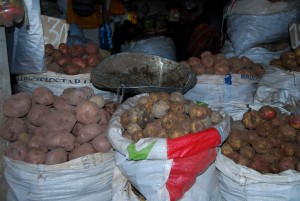
Today the provinces of Cuzco produce a great quantity of potatoes. This results from the quality of our soils which are overflowing with fertility. And the varied climate of Cuzco despite our intense seasonal variation also favors potatoes. That is why from the time of our ancient ancestors until today we have never quit producing potatoes.

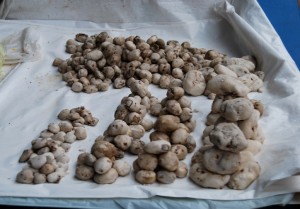
Well before the conquest there was such an abundance of potatoes, the fields all colored by intense potato flowers, that our ancestors used that which they did not consume in fresh form to make dried potatoes (papa seca), and two forms of freeze dried potatoes, chuño and moraya.
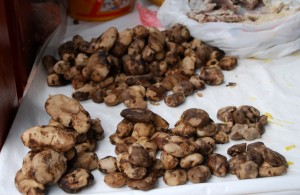
Today we are slowly losing the great legacy of our ancestors. People do not dedicate the same devotion to growing great quantities of potatoes and we are even losing the rich variety of seed adapted to our specific ecological niches. As a result, various projects are attempting to show people the value of the variety of potatoes of seed potatoes. In Pisaq, a region in Cuzco by a great Inca ruin, in the community of Chawaytiri has been created the Route of the Potato, where the members of the community are willing to show the world all that they produce. Just on this route on can find 1267 varieties of potato. This number is even increasing since the people are trying to obtain an even greater variety of seed potatoes in order to grow them and thus help preserve the variety hat otherwise would be lost.
This community is very well organized. They carry out an accounting of how many seed potatoes are harvested each year and how many must be harvested to please the earth. Some of their varieties require fertilizers and others actually make the earth more fertile. Each home has a hatun t’aque, which means great storage bin, where they keep their produce. While this is done in each home, the community also has a hatun t’aque for keeping the comunity’s seed potatoes of newly introduced varieties or others that need more attention.
In all this great variety of potatoes, each has its own range of altitude where it should be planted. Some will take higher altitude than others, but in this community there are potatoes that grow at altitudes higher than 4,000 meters above sea level. Called the ruk’i, it has small flowers and produces a great quantity of new potatoes. But it is bitter, if you try to eat it without processing. As a result it is only used for the production of chuño, blackened, freeze-dried potatoes, the white freeze dried moraya, or the yellowish translucent papa seca. Only through processing and drying does it take on a good flavor.
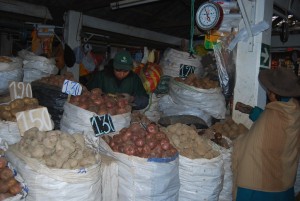
We are losing naturally produced potatoes, since agriculture is relying ever more on chemical fertilizers for potatoes, instead of natural manures. Nevertheless, in Cuzco there are still high Andean communities where potatoes are grown naturally. They still get a large harvest of potatoes and their flavor is particularly good. It is easy to notice this when a traditionally farmed and chemically farmed tomato are tried side by side.
Potatoes usually arrive in Cuzco on Sundays to go to the various markets or stops on the streets where you can see the big bags of newly harvested potatoes waiting for distribution or consumers. The same scent that lets you recognize the kind of potato that is being sold also informs you of the freshness and naturalness of the potatoes.
Potatoes have a lot of antioxidants that help stave off many illnesses. Maybe that is why our ancestors seemed to be healthier than we are today. They had natural and delicious products right from the fields, which today is often missing.
Nevertheless, potatoes are very important to us in Cuzco. That is why we have the popular folk song called “potato flower.”





just came back from Peru and had no idea
this tiny thing was a potato till I saw your article
Thank you for taking the time to post
such important thing on the internet.
This is how we can keep traditions and customs/culture
Alive